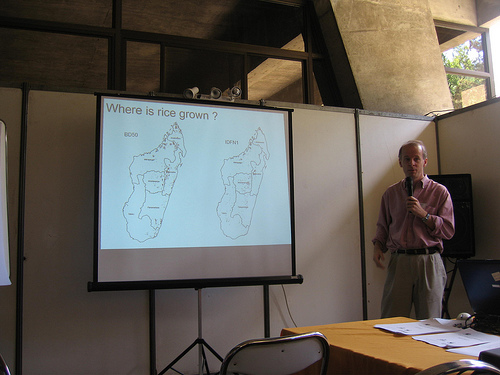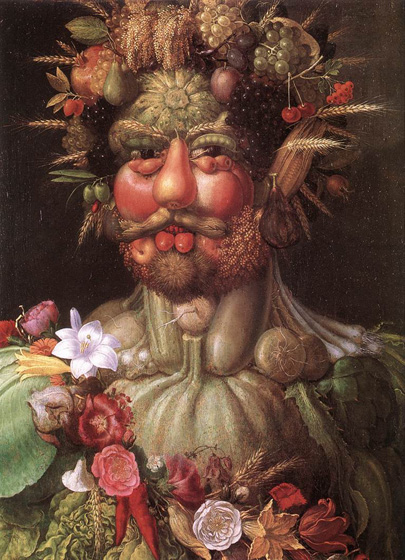Jason at Hominim Dental Anthropology (a bit of a mouthful; hahahaha) has been taking a look at some recent papers on domestication. The papers are, by his own admission, nothing new. We’ve covered some of them ourselves here. What I thought was interesting was the stress on the timing and duration of domestication and Jason’s views of what constitutes “nature” and “natural”. He seems, to me, to be a bit confused as to whether Homo sapiens (just another unique species, as Rob Foley puts it) is a part of nature, or apart from nature and yet with its (our?) own nature.
Agrobiodiversity and climate change in Madagascar
There’s a workshop going on in Antananarivo on the Impacts of Climate Change on Madagascar’s Biodiversity and Livelihoods. My friend Robert Hijmans is there and he sent me the link to the flickr site of one of the participants, Ratoza Harinjaka, who’s got some photos of the meeting up. Including this one of Robert.

Ratoza has kindly given his permission for us to use the photo. He has blogged about the workshop. Thanks for the use of the pic, Ratoza. If either you or Robert would like to write something for us on the meeting, you’re most welcome to do so. It sounds like the recommendations will be on the Foko website in due course. But it’s always nice to get it from the horse’s mouth.
Potato salad
I don’t know if it’s because of the International Year of the Potato, but there’s been a fair amount on the spud in the news lately. I nibbled a few days ago news of a paper which will cause a major rethink on the worldwide spread of the potato. Virtually all modern potato varieties are derived from landraces from the lowlands of southern and central Chile. Why? Some people think it’s because those are the first ones that arrived in Europe. Others that there were also highland Andean varieties in Europe, but that they got wiped out by late blight. But analyzing DNA from old herbarium specimens shows that both types of potatoes were grown in Europe both before and after late blight hit. So a new theory is needed.
Then there was a short piece on the CIP collection in LatinAmericaPress. Note the cool picture of diversity in the colour of potato flesh. I’m not sure what prompted the article, but it may have been a CGIAR press release on how the international centres, including CIP, are sending germplasm for safety duplication in Svalbard in time for the opening in three weeks’ time.
CIP was also in the news with the announcement of the establishment of Red Latinpapa. That’s the Latin American Network for Innovation on Potato Improvement and Dissemination. Its “aim is to help poor potato farmers in Latin America improve their income and reduce costs by making it easier for them to access new technologies and varieties and getting their input into what traits are most useful.” Among other things, “Latinpapa will stimulate exchange and analysis of genetic material between researchers in the region.” A busy time ahead for the CIP genebank, and national genebanks around the region, I guess.
And finally, a bit of fun. Remember the picture of sliced potatoes in the LatinAmericaPress article showing lots of different colours and patterns? Of course, because of the relatively narrow base of modern potato varieties, as described in that USDA paper I started with, we don’t get potato chips (crisps for the Brits among us) in all these different colours. Bummer.
But maybe we will soon. Someone in Switzerland is indeed working on a blue chip. But in fact mixtures of blue and white chips are already commercially available in the US. Although they “have a weird flavor that is not quite potato.” Sounds intriguing…
Hot cocoa
 The Fairtrade Foundation licenses this special mark to distinguish products that have been certified as meeting certain producer and trading standards, meant to ensure that small-scale producers and plantation workers in the developing world get a better deal. The producers “receive a minimum price that covers the cost of sustainable production and an extra premium that is invested in social or economic development projects.” And farmers are thus given an incentive to maintain agrobiodiversity on farm. However, as an article in last week’s Economist points out, this model is not particularly popular among the large corporations that control the global trade in agricultural commodities: “Fairtrade’s price-adjustment mechanism is intended to insulate small producers from volatile commodity markets and the free-trading, no-holds-barred capitalism that multinational companies espouse.”
The Fairtrade Foundation licenses this special mark to distinguish products that have been certified as meeting certain producer and trading standards, meant to ensure that small-scale producers and plantation workers in the developing world get a better deal. The producers “receive a minimum price that covers the cost of sustainable production and an extra premium that is invested in social or economic development projects.” And farmers are thus given an incentive to maintain agrobiodiversity on farm. However, as an article in last week’s Economist points out, this model is not particularly popular among the large corporations that control the global trade in agricultural commodities: “Fairtrade’s price-adjustment mechanism is intended to insulate small producers from volatile commodity markets and the free-trading, no-holds-barred capitalism that multinational companies espouse.”
And yet, Fairtrade-like strategies — The Economist calls them “Fairtrade lite” — are increasingly popular: “firms are finding ways to improve the lot of small farmers, and burnish their own reputations, without signing up to Fairtrade’s rules.” The article describes the latest example.
It is called the “Cadbury Cocoa Partership,” and it commits that multinational to investing US$87 million over 10 years in increasing cacao yields in Ghana. That country provides Cadbury Shweppes with 70% of its global needs (100% of its UK needs), amounting to 10% of Ghana’s production. A recent study showed that yields have been decreasing and youngsters leaving the farms, imperilling supply. Cadbury does use a Fairtrade-certified cocoa (from Belize), but in this case it decided that the problem was not so much price as productivity, and came up with its own scheme.
Intercropping will be encouraged (peppers, mangoes, coconuts) as an additional income option, wells dug to free up the time of women and girls, and schools and libraries built, equipped and staffed. But it is unclear how productivity is to be increased. The article says that “the aim of the venture is to show cocoa farmers how to increase yields using fertilisers and by working with each other.” Surely that’s not going to be enough. Hopefully cacao genetic resources conservation, evaluation and breeding work will also be supported. 1
Vertemnus
I finally got online again at home last week, so I spent a lazy Sunday exploring podcasts and the like, and in the course of that I ran across a radio programme on BBC Radio 4 on the Holy Roman Emperor Rudolf II which sounded interesting. So I click on the appropriate link and on the programme’s webpage I find reproduced a detail of this painting:

Now, I knew this painting, but only insofar as it features on the front cover of the International Treaty on Plant Genetic Resources for Food and Agriculture, and indeed on its website. I suppose I should have known that it is by Giuseppe Arcimboldo, dates from 1591, and represents the said Rudolf II as the mythical Vertemnus, god of harvests and abundance. But I didn’t. I have admired it — and marvelled at how apposite it is as an illustration of the Seed Treaty, with all that agricultural biodiversity — many times, but never really thought about it further. Before now. Which is a pity, because if I had I would also have found out about the similar series of paintings Arcimboldo did on the seasons. And about the website Eat Online, devoted to representations of food and eating in the arts.